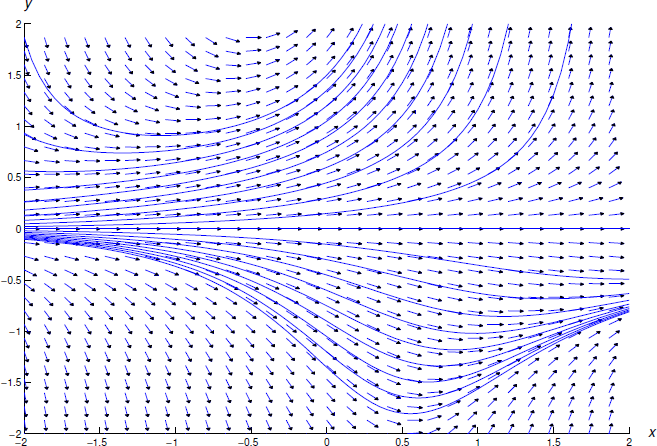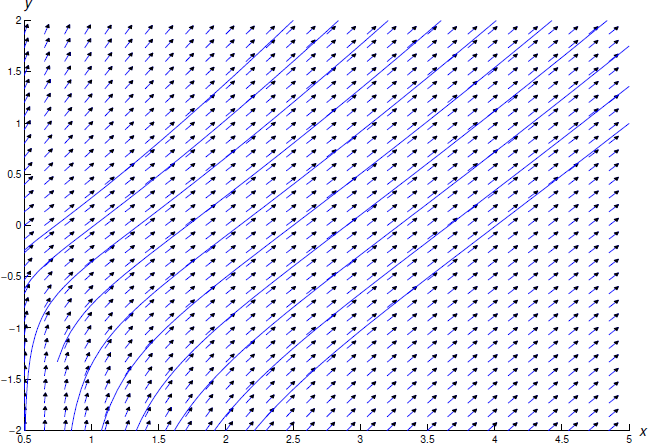2.4: Solving Differential Equations by Substitutions
- Page ID
- 103474
\( \newcommand{\vecs}[1]{\overset { \scriptstyle \rightharpoonup} {\mathbf{#1}} } \)
\( \newcommand{\vecd}[1]{\overset{-\!-\!\rightharpoonup}{\vphantom{a}\smash {#1}}} \)
\( \newcommand{\id}{\mathrm{id}}\) \( \newcommand{\Span}{\mathrm{span}}\)
( \newcommand{\kernel}{\mathrm{null}\,}\) \( \newcommand{\range}{\mathrm{range}\,}\)
\( \newcommand{\RealPart}{\mathrm{Re}}\) \( \newcommand{\ImaginaryPart}{\mathrm{Im}}\)
\( \newcommand{\Argument}{\mathrm{Arg}}\) \( \newcommand{\norm}[1]{\| #1 \|}\)
\( \newcommand{\inner}[2]{\langle #1, #2 \rangle}\)
\( \newcommand{\Span}{\mathrm{span}}\)
\( \newcommand{\id}{\mathrm{id}}\)
\( \newcommand{\Span}{\mathrm{span}}\)
\( \newcommand{\kernel}{\mathrm{null}\,}\)
\( \newcommand{\range}{\mathrm{range}\,}\)
\( \newcommand{\RealPart}{\mathrm{Re}}\)
\( \newcommand{\ImaginaryPart}{\mathrm{Im}}\)
\( \newcommand{\Argument}{\mathrm{Arg}}\)
\( \newcommand{\norm}[1]{\| #1 \|}\)
\( \newcommand{\inner}[2]{\langle #1, #2 \rangle}\)
\( \newcommand{\Span}{\mathrm{span}}\) \( \newcommand{\AA}{\unicode[.8,0]{x212B}}\)
\( \newcommand{\vectorA}[1]{\vec{#1}} % arrow\)
\( \newcommand{\vectorAt}[1]{\vec{\text{#1}}} % arrow\)
\( \newcommand{\vectorB}[1]{\overset { \scriptstyle \rightharpoonup} {\mathbf{#1}} } \)
\( \newcommand{\vectorC}[1]{\textbf{#1}} \)
\( \newcommand{\vectorD}[1]{\overrightarrow{#1}} \)
\( \newcommand{\vectorDt}[1]{\overrightarrow{\text{#1}}} \)
\( \newcommand{\vectE}[1]{\overset{-\!-\!\rightharpoonup}{\vphantom{a}\smash{\mathbf {#1}}}} \)
\( \newcommand{\vecs}[1]{\overset { \scriptstyle \rightharpoonup} {\mathbf{#1}} } \)
\( \newcommand{\vecd}[1]{\overset{-\!-\!\rightharpoonup}{\vphantom{a}\smash {#1}}} \)
Bernoulli Equations
A Bernoulli equation is an equation of the form
\[\label{eq:2.4.2} {dy\over dx}+p(x)y=f(x)y^r,\]
where \(r\) can be any real number other than \(0\) or \(1\). (Note that Equation \ref{eq:2.4.2} is linear if and only if \(r=0\) or \(r=1\).)
The substitution \(u=y^{1-r},\) will turn the Bernoulli Equation \ref{eq:2.4.2} into a linear equation.
Dividing \ref{eq:2.4.2} by \(y^r\) yields \[y^{-r}{dy\over dx}+p(x)y^{1-r}=f(x).\nonumber\]
If we make the substitution \[u=y^{1-r}\nonumber\] and differentiate with respect to x we get \[{du\over dx}=(1-r)y^{-r}{dy\over dx.}\nonumber\]
From this we can see that \ref{eq:2.4.2} becomes \[{1\over 1-r}{du\over dx}+p(x)u=f(x)\nonumber\] which is linear and can be solved by the methods of section 2.3.
Solve the Bernoulli equation
\[\label{eq:2.4.3} y'-y=xy^2.\]
Solution
Dividing by \(y^2\) we get
\[y^{-2}y'-y^{-1}=x.\nonumber\]
If we now let \(u=y^{-1},\) we get \({du\over dx}=-y^{-2}{dy\over dx}\) and substituting into \ref{eq:2.4.3} we get
\[{-du\over dx}-u=x\nonumber\]
which is a linear equation. Putting it in standard linear form we get
\[{du\over dx}+u=-x\nonumber\]
and using the method of section 2.3 we get the solution
\[u=-{(x-1)+ce^{-x}} \nonumber\]
and substituting back in for u we get
\[y^{-1}=-{(x-1)+ce^{-x}} \nonumber\]
and solving for y we get our final solution
\[y=-{1\over x-1+ce^{-x}}. \nonumber\]
Figure 2.4.1 shows the direction field and some integral curves of Equation \ref{eq:2.4.3}.

Homogeneous Equations
We say that a function \(f(x,y)\) is homogeneous of degree n if
\[f(tx,ty)=t^nf(x,y)\nonumber\]
Determine if \[f(x,y)=x^5+x^2y^3\nonumber\] is a homogeneous function and, if so, of what degree.
Solution
Substituting \(tx\) for \(x\) and \(ty\) for \(y\) we get \[f(tx,ty)=(tx)^5+(tx)^2(ty)^3=t^5(x^5+x^2y^3)=t^5f(x,y).\nonumber\] Therefore, \(f(x,y)\) is a homogeneous function of degree 5.
Determine if \[f(x,y)=x^2+xy^2\nonumber\] is a homogeneous function and, if so, of what degree.
Solution
Substituting \(tx\) for \(x\) and \(ty\) for \(y\) we get \[f(tx,ty)=(tx)^2+(tx)(ty)^2=t^2(x^2+txy^2)\ne t^nf(x,y).\nonumber\] for any number \(n\). Therefore, \(f(x,y)\) is not a homogeneous function.
Note: For this type of differential equation, as in section 2.2, it is convenient to write first order differential equations in the form
\[\label{eq:2.5.1} M(x,y)\,dx+N(x,y)\,dy=0.\]
We say that a differential equation of the form \(M(x,y)\,dx+N(x,y)\,dy=0\) is homogeneous if \(M(x,y)\) and \(N(x,y)\) are homogeneous functions of the same degree.
Determine if \[(x^2+xy)dx+y^2dy=0\nonumber\] is a homogeneous differential equation.
Solution
Substituting \(tx\) for \(x\) and \(ty\) for \(y\) in \(M(x,y)\) we get \[M(tx,ty)=(tx)^2+(tx)(ty)=t^2(x^2+xy)= t^2M(x,y)\nonumber\] and \(M(x,y)\) is a homogeneous function of degree 2.
Substituting \(tx\) for \(x\) and \(ty\) for \(y\) in \(N(x,y)\) we get \[N(tx,ty)=(ty)^2=t^2y^2= t^2N(x,y)\nonumber\] and \(N(x,y)\) is a homogeneous function of degree 2.
Since both \(M(x,y)\) and \(N(x,y)\) are homogeneous functions of degree 2, the differential equation is homogeneous.
The substitution \(y=ux\), where \(u\) is a function of \(x\), or \(x=vy\), where \(v\) is a function of \(y\) will make a homogeneous equation separable.
Note: we will only prove this for the substitution \(y=ux\) and leave the substitution \(x=vy\) to the reader.
Letting \[y=ux\nonumber\] and differentiating with respect to \(x\) we get
\[{dy\over dx}=u+x{du\over dx}\nonumber\] which can be rewritten as \[dy=udx+xdu.\nonumber\]
Substituting \(y\) and \(dy\) into \ref{eq:2.5.1} we get \[M(x,ux)dx+N(x,ux)[udx+xdu]=0.\nonumber\]
Using the fact that both \(M(x,y)\) and \(N(x,y)\) are homogeneous of the same degree we get
\[x^nM(1,u)dx+x^nN(1,u)[udx+xdu]=0.\nonumber\]
Expanding and rewriting this we eventually come to
\[x^n[M(1,u)+uN(1,u)]dx=-x^{n+1}N(1,u)du\nonumber\] which is clearly a separable differential equation:
\[{1\over x}dx={-N(1,u)\over M(1,u)+uN(1,u)}du.\nonumber\]
Solve
\[\label{eq:2.4.8} xdy=({y+xe^{-y/x}})dx.\]
First verify that \(M(x,y)\) and \(N(x,y)\) are homogeneous functions of the same degree.
Substituting \(y=ux\) into Equation \ref{eq:2.4.8} yields
\[x(udx+xdu)= ({ux+xe^{-ux/x}})dx.\nonumber\]
Simplifying and separating variables yields
\[e^udu={1\over x}dx. \nonumber\]
Integrating yields \(e^u=\ln |x|+c\). Therefore \(u=\ln(\ln|x|+c)\) and \(y=ux=x \ln (\ln |x|+c)\).
Figure 2.4.2 shows a direction field and integral curves for Equation \ref{eq:2.4.8}.

Equations of the form \({dy\over dx}=f(Ax+By+C)\)
The substitution \[u=Ax+By+C\nonumber\] will make equations of the form \[\label{eq:2.4.9} {dy\over dx}=f(Ax+By+C)\] separable.
Consider a differential equation of the form \ref{eq:2.4.9}.
Let \[u=Ax+By+C\nonumber\]
Taking the derivative with respect to x we get \[{du\over dx}=A+B{dy\over dx}.\nonumber\]
Substituting into \ref{eq:2.4.9} we get \[{1\over B}({du\over dx}-A)=f(u)\nonumber\]
which is clearly a separable differential equation: \[{du\over Bf(u)+A}=dx\nonumber\]
Solve
\[\label{eq:2.4.10} y'=sec^2(y-x-3).\]
Solution
Letting \[u=y-x-3\nonumber\] and differentiating we get \[{du\over dx}={dy\over dx}-1\nonumber\]
Substituting into Equation \ref{eq:2.4.10} we get
\[{du\over dx}+1=sec^2u\nonumber\]
This is now a separable equation which can be solved using the method of section 2.1, resulting in a solution of
\[-\cot u-u=x+c\nonumber\]
and substituting in for u we get
\[-\cot (y-x-3)-(y-x-3)=x+c\nonumber\] and simplifying we get
\[\cot (y-x-3)=-y+c\nonumber\]


